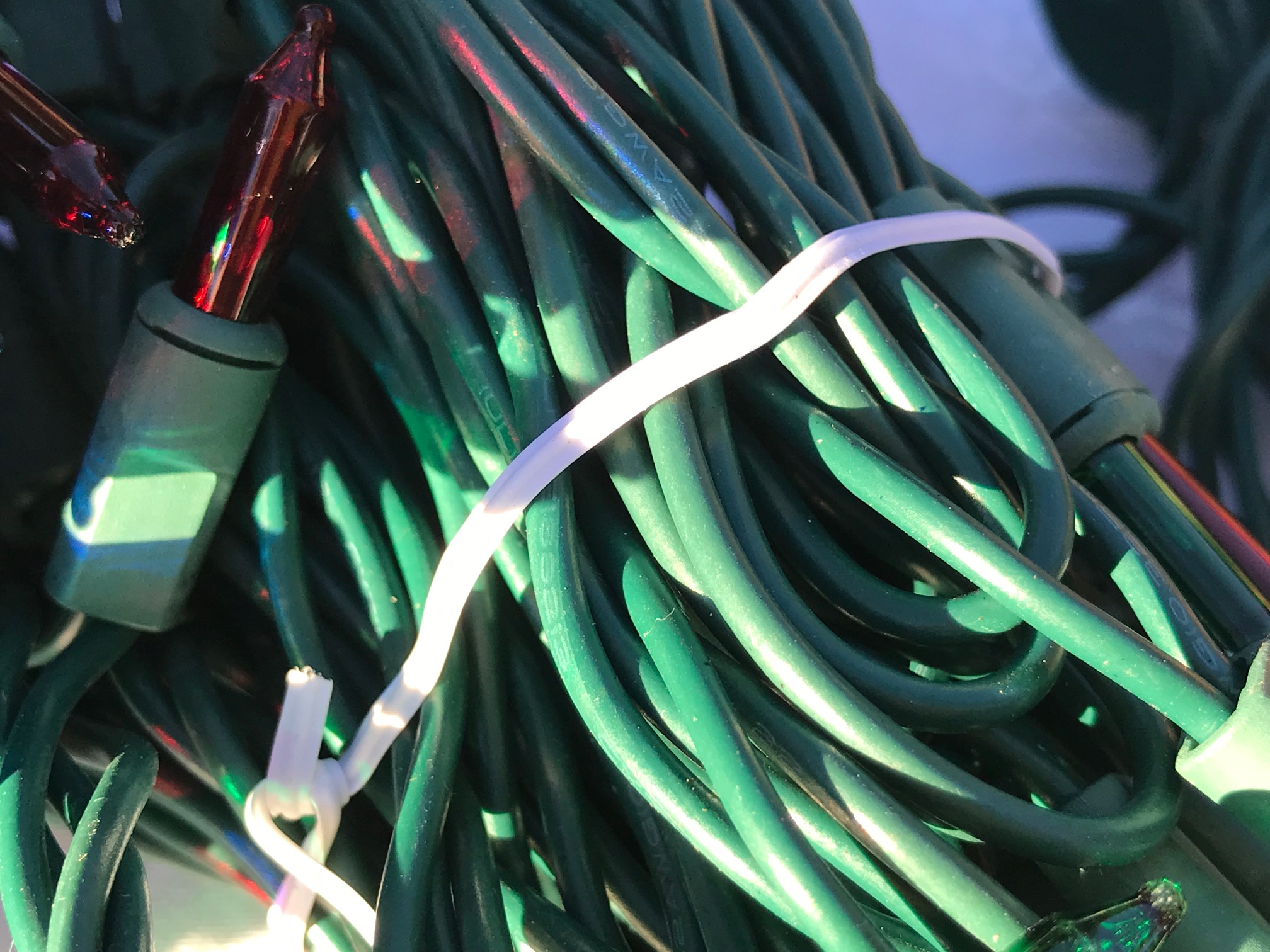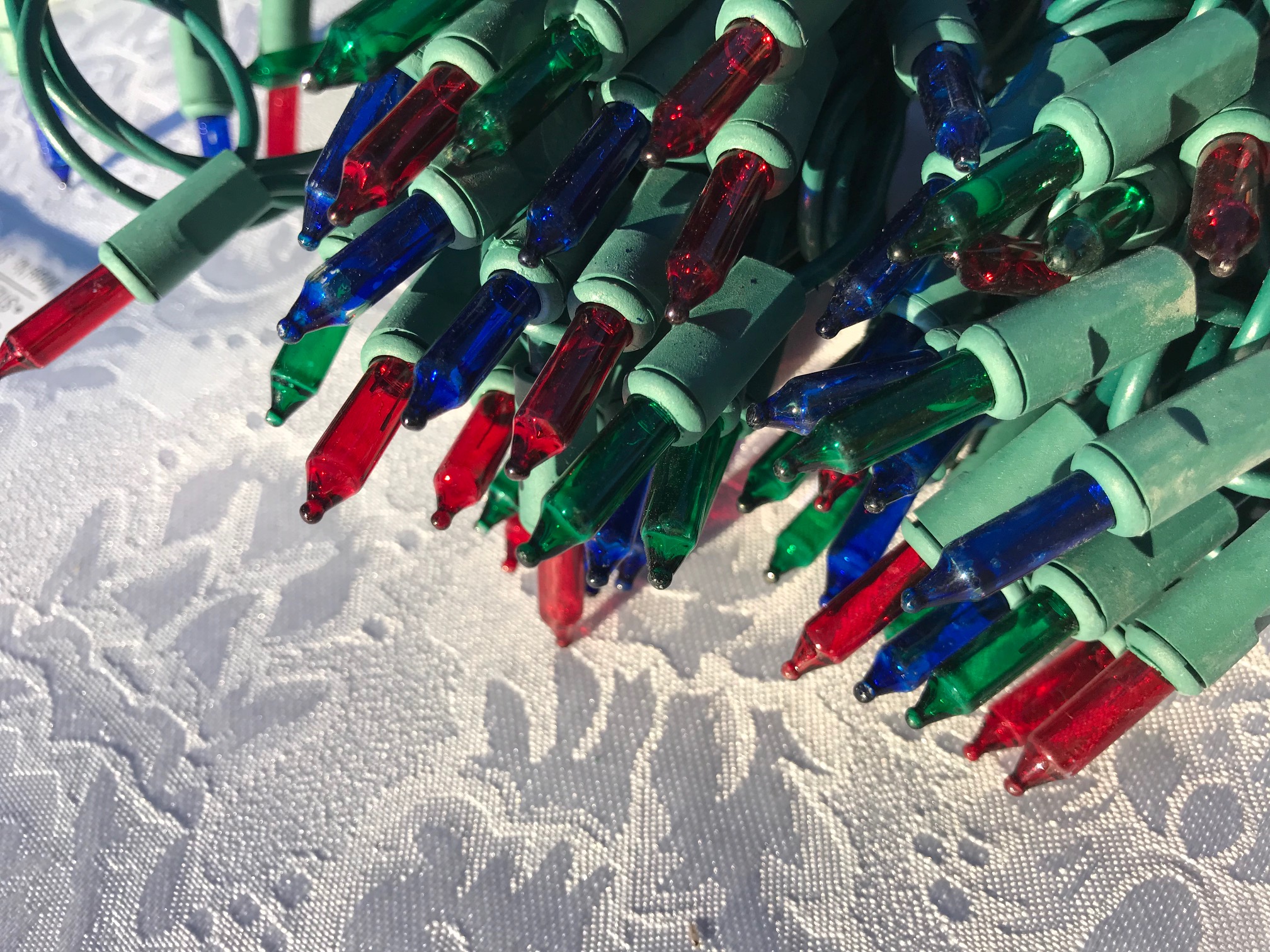Walmart Holiday Time plug-in Christmas Lights: Lead-free! (8,188 ppm Antimony — a fire retardant & known carcinogen)
This newly-purchased (2018) set of Walmart brand “Holiday Time” 16 Function Multicolor Mini Lights (pictured above with 150 lights and a green wire strand) was tested with an XRF instrument. It was not disassembled for testing, so only accessible parts that one would normally touch when using them (installing them or operating them) were tested.
Disclaimer: It is always possible that there is some Lead (or other toxicants) in components that are inaccessible with the XRF (without disassembly) or in components that are extremely difficult to test with an XRF, due to their shape and/or size (for example, the actual tiny lightbulbs themselves).
UPDATE: I had originally had LED in the title, but — bucking the current nearly universal move away from incandescent lightbulbs to (more energy-efficient, less-breakable) LEDs — it turns out these little guys are not LEDs, rather old-fashioned tiny glass lightbulbs.
They had the following XRF readings (with all accessible components tested):
- Lead (Pb): Non-Detect / Negative
- Mercury (Hg): Non-Detect / Negative
- Cadmium (Cd): Non-Detect / Negative
NOTE: This set differs from the Walmart set posted earlier (the battery-operated set) — in that there is Antimony (Sb) in most of the components. Antimony is a common ingredient in fire retardants.
ANOTHER UPDATE: With additional testing of this product (prompted by my findings of Arsenic in the Target brand of lights, LINK) I also found trace arsenic in the hard green plastic at the base of the bulbs in this set of lights. Specific test results showing levels of Arsenic and Antimony are listed below.
I also want to be clear that even with these considerations, I think these modern lights are a LOT better choice than their vintage (or even 10-year-old) counterparts that are generally very high Lead!
Scroll down through all of the photos for the additional specific XRF readings for each component.
… continue reading below the images …
Green Wire:
- Antimony (Sb): 8,188 +/- 184 ppm
- Chromium (Cr): 442 +/- 198 ppm
- Bromine (Br): 1,154 +/- 35 ppm
- Zinc (Zn): 615 +/- 48 ppm
- Copper (Cu): 521 +/- 63 ppm
- Iron (Fe): 406 +/- 93 ppm
- Titanium (Ti): 2,964 +/- 1,649 ppm
Green Hard Plastic at the Base of Bulbs:
- Antimony (Sb): 24,900 +/- 800 ppm
- Arsenic (As): 54 +/- 18 ppm
- Bromine (Br): 74,300 +/- 2,500 ppm
- Zinc (Zn): 2,466 +/- 101 ppm
- Vanadium (V): 861 +/- 295 ppm
- Titanium (Ti): 1,496 +/- 478 ppm
… continue reading below the images …
Green Hard Plastic Controller Enclosure:
- Antimony (Sb): 267 +/- 23 ppm
- Bromine (Br): 810 +/- 12 ppm
- Tin (Sn): 447 +/- 19 ppm
- Nickel (Ni): 15 +/- 7 ppm
- Iron (Fe): 38 +/- 17 ppm
- Bismuth (Bi): 29 +/- 9 ppm
- Titanium (Ti): 5,754 +/- 308 ppm
… continue reading below the images …
Green Hard Plastic Part of the Plug:
- Antimony (Sb): 1,189 +/- 31 ppm
- Barium (Ba): 147 +/- 92 ppm
- Selenium (Se): 16 +/- 3 ppm
- Bromine (Br): 35 +/- 3 ppm
- Zinc (Zn): 774 +/- 20 ppm
- Copper (Cu): 1,467 +/- 30 ppm
- Iron (Fe): 22 +/- 14 ppm
- Titanium (Ti): 999 +/- 209 ppm
… continue reading below the images …
One sample test of bulbs (multiple colors in frame):
- Antimony (Sb): 4,277 +/- 196 ppm
- Barium (Ba): 2060 +/- 446 ppm
- Chromium (Cr): 297 +/- 196 ppm
- Bromine (Br): 390 +/- 24 ppm
- Copper (Cu): 95 +/- 46 ppm
- Iron (Fe): 976 +/- 135 ppm
- Bismuth (Bi): 185 +/- 33 ppm
For another comprehensive set of test results (showing all metals found) for a set of LED battery-operated lights from the same brand/ company, click HERE.
To learn more about XRF testing, click HERE.
Click here to see these exact lights on Walmart’s site.
Publishing a product on my site does not necessarily mean I recommend that product. It is an opportunity for consumers to educate themselves about potential toxicants in consumer goods. I hope that with every article you will read the information, learn about issues or related considerations, and then use that information to make an informed choice about the things you use in your home.
As always, please let me know if you have any questions.
Thank you for reading and for sharing this work.
Tamara Rubin
#LeadSafeMama
Links are NOT Walmart affiliate links because I don’t yet have that set up! 🙂
For those new to this website:
Tamara Rubin is a multiple-federal-award-winning independent advocate for childhood Lead poisoning prevention and consumer goods safety, and a documentary filmmaker. She is also a mother of Lead-poisoned children (two of her sons were acutely Lead-poisoned in 2005). Since 2009, Tamara has been using XRF technology (a scientific method used by the U.S. Consumer Product Safety Commission) to test consumer goods for toxicants (specifically heavy metals — including Lead, Cadmium, Mercury, Antimony, and Arsenic). All test results reported on this website are science-based, accurate, and replicable. Items are tested multiple times to confirm the test results for each component tested. Tamara’s work was featured in Consumer Reports Magazine in February of 2023 (March 2023 print edition).
Never Miss an Important Article Again!
Join our Email List



















Would it be possible to test the LED version of these plug in Holiday Time green wire lights? I just bought a bunch (cool white) and (red). I will provide a donation for your time, just send me the link. Thank you!
Would you guess that modern (2019) lights purchased from home depot would have similar reading? definitely concerned about antimony, but want to know that at least there is no lead.
It depends on the brand and the warning labels. With a prop-65 label they likely have Lead.
Why do you think that the LED lights from the same company had no antimony? Is it because of the LED lights vs incandescent or different wiring perhaps? Is there a way to know if lights have antimony? Have you tested Ikea lights?
Thank you in advance,
Joanna